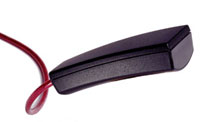RedRat + Raspberry Pi
If you have got a RedRat like this:
 And a Raspberry Pi like this:
And a Raspberry Pi like this:

You can set up the Raspberry Pi to send Infra Red commands using the following instructions:
These instructions are for the Raspberry Pi.
But, are probably generic for all Linux installations.
Setup LIRC
Firstly, install 'lirc'.
> sudo apt-get install lirc
Next, edit /etc/lirc/hardware.conf:
set DEVICE="/dev/lirc0"
set DRIVER to "default"
set LIRCD_CONF to "/etc/lirc/lircd.conf"
The /dev/lirc0 is probably used as default
But, you might need to make a sym link to it from lirc like this:
> cd /dev
> sudo ln -s lirc0 lirc
Now, you need a valid /etc/lirc/lircd.conf file.
Copy this 'freesat' file to /etc/lirc and call it lircd.conf
The 'freesat' file can be obtained here
This is the config file for one of these:
 Which are common in the UK and come with Bush/Goodmans branded Freesat set-top-boxes.
If you have a different remote control which you want to simulate
with the RedRat then you will need a different config file.
Maybe the people at 'lirc' already have profiled the one you want.
Contact to see their list of remote controls.
For Redrat
> sudo apt-get install ir-keytable
Then, run ir-keytable to see if the RedRat is detected.
(Insert the redrat first).
> ir-keytable
It should show some driver info.
To start the lircd deamon use:
> sudo service lirc start
(Note, lirc, not lircd)
To check if lircd is running use:
> pidof lircd
If you see a number then it's running OK.
Sending IR Commands
So, now with a valid lircd.conf file, and lircd running you can send IR messages
like this:
> irsend SEND_ONCE brandname KEY_OK
That will send (once) the KEY_OK IR sequence out of the redrat using the 'brandname' config.
So, if you previously made a /etc/lirc/lircd.conf file from a freesat remote, use 'freesat' as
the brandname.
If your STB isn't responding check that there is a KEY_OK section in the /etc/lirc/lircd.conf file.
Also, you might want to try pointing your smart phone camera, or
digital camera at the redrat when it's sending the IR sequence.
IR is invisible to the human eye, but seen through a digital camera you
can clearly see some red flashes. That will tell you if something is coming out or not.
Which are common in the UK and come with Bush/Goodmans branded Freesat set-top-boxes.
If you have a different remote control which you want to simulate
with the RedRat then you will need a different config file.
Maybe the people at 'lirc' already have profiled the one you want.
Contact to see their list of remote controls.
For Redrat
> sudo apt-get install ir-keytable
Then, run ir-keytable to see if the RedRat is detected.
(Insert the redrat first).
> ir-keytable
It should show some driver info.
To start the lircd deamon use:
> sudo service lirc start
(Note, lirc, not lircd)
To check if lircd is running use:
> pidof lircd
If you see a number then it's running OK.
Sending IR Commands
So, now with a valid lircd.conf file, and lircd running you can send IR messages
like this:
> irsend SEND_ONCE brandname KEY_OK
That will send (once) the KEY_OK IR sequence out of the redrat using the 'brandname' config.
So, if you previously made a /etc/lirc/lircd.conf file from a freesat remote, use 'freesat' as
the brandname.
If your STB isn't responding check that there is a KEY_OK section in the /etc/lirc/lircd.conf file.
Also, you might want to try pointing your smart phone camera, or
digital camera at the redrat when it's sending the IR sequence.
IR is invisible to the human eye, but seen through a digital camera you
can clearly see some red flashes. That will tell you if something is coming out or not.
You might want to take this process one step further and install stb-tester.
It uses RedRat (as above), and also gstreamer - and a video capture USB device to
further automate testing of set-top-boxes by sending IR commands to the set-top-box, and
then checking the TV (through the video capture device) to see if the desired response has
been achieved. It's useful for un-manned testing.
 Which are common in the UK and come with Bush/Goodmans branded Freesat set-top-boxes.
If you have a different remote control which you want to simulate
with the RedRat then you will need a different config file.
Maybe the people at 'lirc' already have profiled the one you want.
Contact
Which are common in the UK and come with Bush/Goodmans branded Freesat set-top-boxes.
If you have a different remote control which you want to simulate
with the RedRat then you will need a different config file.
Maybe the people at 'lirc' already have profiled the one you want.
Contact  And a Raspberry Pi like this:
And a Raspberry Pi like this: